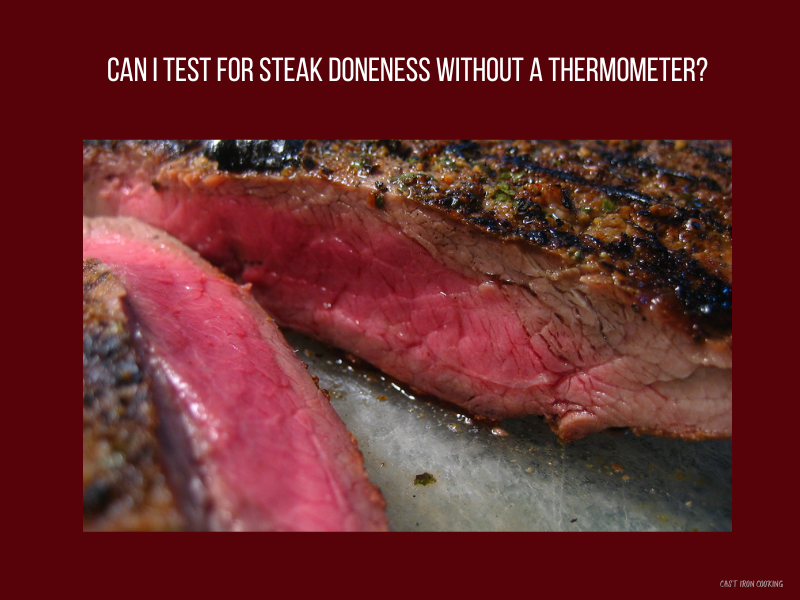Are you one of the millions of people who enjoy a good steak?
I can truthfully say I do now.
But with the cost of beef so high, you might be thinking, “Who can afford to order steak at a restaurant?”
In that case, buying and making your own might be your best option.
Or maybe you prefer making your own regardless but don’t have a meat thermometer.
So, how will you know your steak is done?
Let’s find out.
Table of Contents
Can I Test for Steak Doneness Without a Thermometer?
Yes, you can test for steak doneness using the finger test. The finger test is when you lightly touch each finger to your thumb. And with a finger from your other hand, push down on the fleshy part below the thumb to determine what your steak will feel like when it is rare, medium-rare, medium, and well-done. However, this method takes practice and isn’t as accurate as a meat thermometer.
The Finger Test
I learned the finger test from my son-in-law, a butcher who loves cooking steak. He is the one who piqued my interest in cast iron and searing steaks, two things close to his heart.
He is comfortable using the finger test and very accurate, but that wasn’t always the case. He had to practice in the beginning because that’s what it takes.
Many chefs, who cook lots of steaks every day, always use this method. It’s quicker, and that’s crucial for them.
Even though quickness may not be as vital for the home chef, it is still an excellent method to know. Because you never know when a meat thermometer won’t be available.
So, what is the finger test?
It’s not as easy to describe as it is to demonstrate, so watch the video below if you want to see how it’s done.
But here is the gist of it: touch each one of your fingers lightly to your thumb (making the okay symbol), and with a finger from your other hand, push down on the meaty part below the thumb.
Each finger will cause the fleshy part to feel different and indicate how a rare, medium-rare, medium/medium-well, and well-done steak feels.
Instructions
Connect your forefinger to your thumb making the okay sign. Now touch the fleshy part below the thumb using a finger from your other hand. It should feel quite squishy. Now touch the steak, and you will know it is cooked rare if the steak feels the same way.
Your middle finger to your thumb will feel a little less squishy and let you know how a medium-rare steak will feel.
The ring finger indicates medium to medium-well, and the pinky will make the meaty part below the thumb feel somewhat firm, the way well-done steak feels.
As a side note, touching the fleshy part at the base of your thumb of an open hand is what a raw to blue steak feels like.
RELATED > > > > > Is It Safe to Eat Blue Steak?
How to Test Steak Tenderness/Doneness
What’s Wrong With Using a Meat Thermometer?
Most people will tell you there is nothing wrong with using a meat thermometer. But for those who prefer the finger test, they may site reasons such as:
- It’s quicker and easier
- There’s no chance of any of the juices escaping
- It’s one less kitchen tool you have to worry about
- They simply like the finger test better
Just Get a Meat Thermometer
While reading a forum on this question, the consensus seemed to be, “Just get a thermometer.”
Their reasons for saying this?
- The finger test is less accurate and difficult to master.
- You may “ruin” many steaks in the learning process.
Some people maintain that accuracy is everything.
And unless you are a chef who cooks several steaks every night in the same conditions, you will probably mess up.
When the chef messes up and overcooks a steak in a restaurant, they can be assured that someone else will soon order a steak that way. So, it doesn’t go to waste.
But when a home cook messes up, they are likely stuck with the steak they made.
Additionally, the home cook probably isn’t cooking steaks every night and may get out of practice.
Therefore, it makes more sense to use a meat thermometer to give you the internal temperature and be accurate every time.
So, what are the internal temperatures, you might ask?
I will tell you.
Internal Temperatures for Steak Doneness
| Blue | 110-115°F | 43-46°C | cool, purplish center |
| Rare | 120-125°F | 49-52°C | cool, red center |
| Medium-rare | 130-135°F | 54-57°C | warm, red center |
| Medium | 140-145°F | 60-63°C | warm, pink center |
| Medium-well | 150-155°F | 65-68°C | light pink center |
| Well | 160-170°F | 71-77°C | no color, dry |
Anything beyond 170°F is like leather and won’t taste good.
To learn more, click on The Ultimate Guide to Steak Temperatures.
Final Thoughts
Well, that’s about all I have.
Hopefully, you now know how to test for steak doneness without using a thermometer.
And can decide if the finger test is something you would like to use to determine when your steak is done.
The finger test is practical, and if you want to try it, you should.
However, don’t worry if you would rather use a meat thermometer.
I use mine, but not with steak so far.
Like I said earlier, my son-in-law taught me the finger test, and I’ve used it and done pretty well. But neither my husband nor I am as picky about accuracy.
And almost any temperature will be safe to eat.
On the other hand, if we were making steak for company, I would probably use a meat thermometer.
What about you?
If you would like to know more about a great digital meat thermometer, check out my review.

